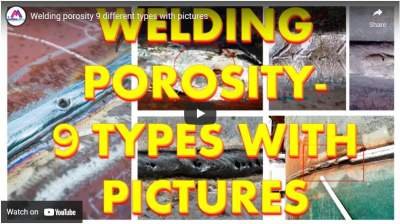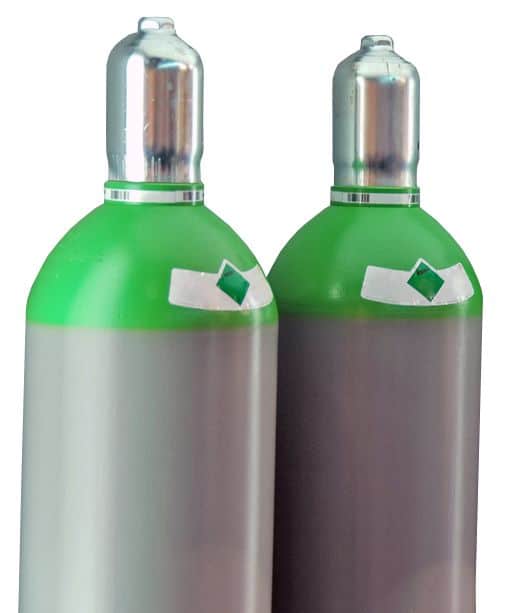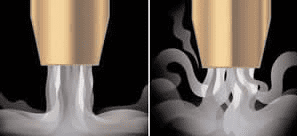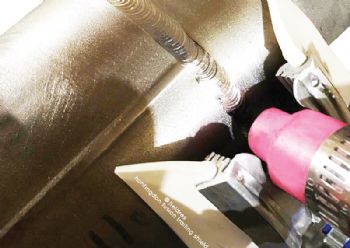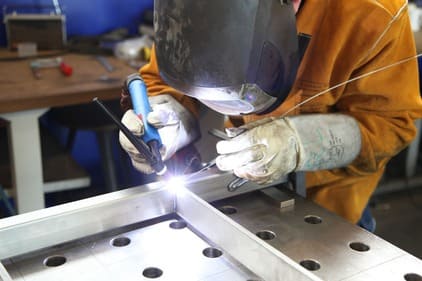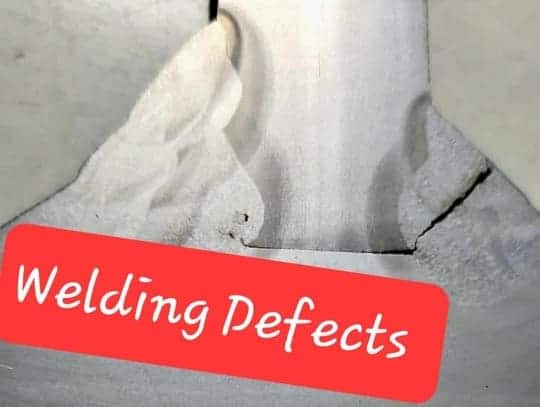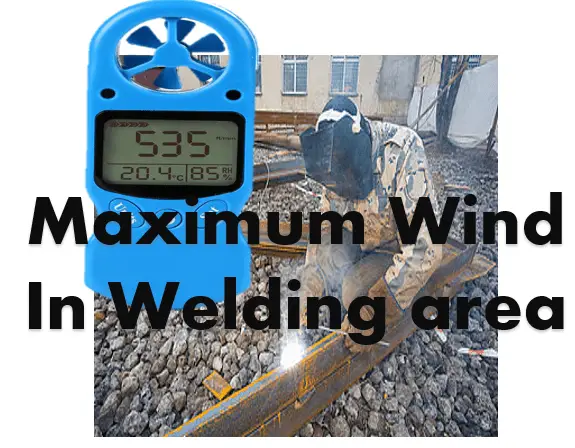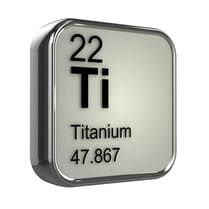What is Porosity in Welding?
Welding porosity is a Metallurgical Discontinuity that results as pores during weld solidification due to the release of dissolved gases in the weld metal. These pores can be either single or a group of pores, and is called welding porosity.
You will observe these porosities on welded parts as a single pores, groups of porosities as a local cluster, or scattered over the welding.
During welding various gases (carbon dioxide, oxygen, nitrogen, hydrogen, and argon or helium) are evolved by the chemical reactions in the welding arc & transferred to the weld pool. As we know, the solubility of gases increases with the increase in material temperature and vice-versa.
So during welding, gases are bound to dissolve in the weld metal but as the weld metal solidifies and cools down, the solubility of these gases decreases rapidly and they try to escape from the weld metal.
Sometimes if the weld-metal solidification and cooling are too rapid, the gas gets entrapped in the form of porosity in the weld deposit.
How Welding Porosity is Caused?
During welding, the temperature of the weld is high. The solubility of gases also increases with an increase in material temperature and vice-versa. So during welding, gases are bound to dissolve in the weld metal.
If the amount of these dissolved gases present in the weld pool during solidification is more than the solubility limit of these gases in the solid state, they will result in welding porosity.
Carbon dioxide, oxygen, nitrogen, hydrogen, and argon or helium are examples of gases that dissolve in the weld metal.
Out of these gases, hydrogen is the major source of welding porosity in most of the materials except nickel-base alloys.
Welding Defects- Types, their causes, and remedies.pdf
4 Types of Porosity in Welding
Porosity in welding is associated due to metallurgical changes that take place during the welding in the weld metal.
Welding variables such as shielding gas, surface conditions & cleanliness, and arc length are the major factors affecting the absence of porosity in the weld.
Generally following are the main 4 types of Welding Porosity:
- Scattered porosity
- Linear porosity
- Uniform porosity
- Cluster or localized porosity
Further, the types of welding porosities as per AWS are:
- Aligned or Linear Porosity
- Cluster or localized porosity
- Scattered porosity
- Piping porosity
- Elongated porosity
Linear Porosity in Welding
Linear Welding Porosity or Aligned porosity is the type of welding porosity that can be observed as multiple pores in a straight line.
Linear welding porosity occurs most frequently in the root pass of welds and is often regarded as a special case of inadequate Joint penetration.
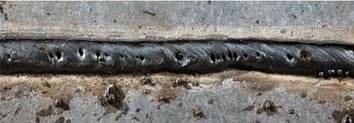
Any defects that line up in a weld are bad and When they occur in the root of the weld, they are worse.
This is because the lined-up pores can get connected together very quickly by short cracks to become one big disastrous failure when the welded component is heavily stressed during service.
Linear porosity can be elongated pores or an array of round porosity. They can appear in the welding root or on the weld surface or between the weld beads.
Causes of Linear or Aligned Porosity
Linear or aligned porosity is caused due to gas release from any contamination such as moisture, grease, paint, or rust at the area where the porosity takes place.
Prevention of Linear/ Aligned Porosity
- Clean the welding area before the start of welding.
- Apply preheat to dry any moisture or other contamination.
- Do not weld on painted or coated surfaces.
Uniform Scattered Porosity
Scattered porosity means the welding pores that are distributed over a weld length instead of concentrated in a small area. In a multi-pass weld, they can be present throughout the passes.
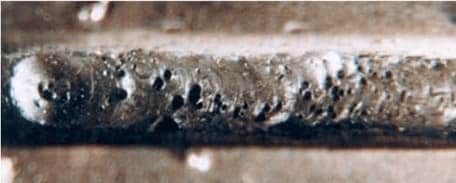
Causes of Scattered Welding Porosity
Scattered porosity is linked with welding operations, welding conditions, and faulty consumables. The main causes of scattered welding porosity are:
- Wrong welding technique e.g. using a high arc length that disables an effective gas shielding blanket on the weld pool.
- Performing welding in windy conditions.
- Contamination in the shielding gas ( E.g. high moisture present in the gas) or using a wrong shielding gas (e.g. using nitrogen as a shielding gas for welding of carbon steel or low alloy steel material).
- Contaminated welding surface (e.g. moisture, rust, paint, grease, or coated welding area).
- Defective material ( E.g. high amount of lead or other low melting elements in base metal).
Prevention of Scattered Welding Porosity
- Ensure the right welding technique. Never use high arc length or weld in windy conditions.
- Clean the weld surface before the start of the weld.
- Verify the right base metal before welding.
- Ensure welding shielding gas is supplied as per AWS A5.32 gas specification.
Cluster Porosity in Welding
Cluster welding porosity means welding pores that are concentrated in a small local area. Cluster porosity is the usually a worse type of porosity in which pores frequently occur in clusters separated by considerable lengths of porosity-free welds.
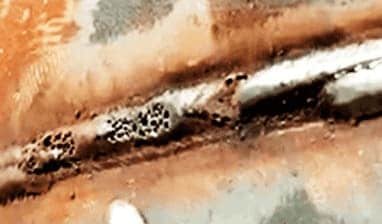
Such clusters are often associated with changes in welding conditions, for example, changes in arc setting when the welder starts or stops welding. In MIG/ MAG or TIG welding, disturbance of shielding gas supply will cause welding porosity similar to cluster porosity as long as shielding gas is absent.
Causes of Cluster Welding Porosity
Cluster porosity in welding occurs during the start & stop of welding so it is linked with poor welding practices for weld start/ stop.
Blockage of shielding gas supply or defective stick welding rod coating will also cause cluster porosity within the affected period duration.
Prevention of Cluster Welding Porosity
Cluster porosity is controlled by using good practices. More emphasis shall be put on welder training to have a good welding initiation and termination.
Ensure the stick welding rod coating is intact and in good condition. In TIG & MIG welding, check there is no uninterrupted supply of shielding gas without any blockage or damage.
Welding Piping Porosity
In some rarer cases during welding, elongated or tubular gas cavities are presented. These are referred to as piping or wormholes porosity as shown in the below picture.
Piping porosity means the type of welding porosity that is having a length more than it’s width. The orientation of piping porosity is perpendicular to the weld.
In the case of a fillet weld, such porosity extends from the weld root to the face side. If 1 or 2 piping pores are visible on the surface, there is a high possibility of many piping porosities under the weld surface.
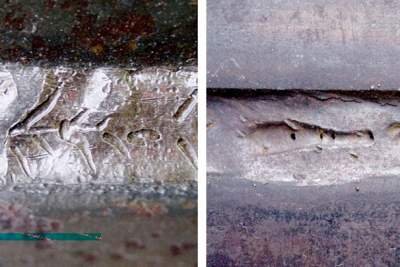
Causes & Prevention of Piping Porosity
The main cause of piping porosity or wormhole in welding is the rapid weld solidification. This is a common problem when welding high arc energy processes such as SAW and electro slag welding.
To prevent piping porosity, control of solidification rate is required either by controlling depth to width ratio or using alternate techniques.
What are the Common Causes for Porosity in Welding?
The most common causes of welding porosity are:
- Wrong filler wires or stick welding rods with insufficient deoxidizer elements (Manganese & silicon).
- Base metal with high impurities (e.g. high sulfur) or high amount of low melting elements such as lead.
- Contaminated weld surface such as oil, greasy, painted, or coated weld surface.
- The high amount of moisture in welding flux or electrode coating.
- Contaminated shielding or purging gases as well as inadequate supply of shielding gases during welding.
- A too high arc length results in an inadequate gas shielding blanket on the weld pool.
- High welding speed can disturb the gas shielding blanket.
- Welding outside in high windy conditions.
- Quick freezing of the weld deposit.
- excessive welding speed because of Which the gas envelope around the weld pool becomes ineffective.
- welding over tack welds made With lightly coated electrodes.
- high welding currents; because high welding current will burn up the deoxidizing elements in stick welding rod & there are not enough deoxidizers lefts to combine with the weld metal before it starts to cool thus causing the porosity.
Prevention & Remedies of Porosity in Welding
Puddling of the weld-metal and use of preheat or higher current allow sufficient time for the dissolved gases to escape from the weld-metal.
If electrodes or fluxes are moist, they should be re-dried in heated ovens according to the recommendations of the consumable producer.
- Re-dry stick welding rods before use & never use dampened rods for welding.
- Preclean surface before welding and eliminate any contaminations.
- Avoid welding in high wind situations, if required use an enclosure around the welding area.
- Regularly check the gas hoses, diffusers, liners, and other parts of the welding machine that aid in the shielding gas supply for any blockage.
- Only buy shielding gases from reputed gas suppliers.
- Use low heat input with a lower current to avoid burn-off of deoxidizers from weld metal.
- Bake welding flux before use.
- Always store the welding consumables in good storing conditions in a humidity-controlled storeroom.
Stick Welding or SMAW Porosity
Welding porosity in stick welding or SMAW welding depends on:
- Welder techniques ( e.g. using a good start-stop method), keeping a short arc length.
- Damaged electrode coating- a damaged coating will not provide sufficient gas shielding & will result in weld porosity.
- Welding on the contaminated surfaces such as rusty, oily, greasy, or painted areas.
- Welding on weld surface with moisture.
- Unbaked welding electrode or rod with high moisture such as dampened rods.
- In stick welding or SMAW of stainless steel, single pores or scattered porosity can result due to moisture present in the rod.
Welding porosity in TIG & MIG welding
Welding porosity in TIG & MIG welding is usually associated with poor quality shielding gases where shielding gas is contaminated (presence of nitrogen in Argon when welding carbon steel material) or has high moisture content.
Other causes are contaminated welding wire (the presence of grease, oil, or moisture on the wire surface) or welding on contaminated material.
One of the noteworthy reasons is the defective nozzle, gas diffuser or liner can also block the shielding gas supply from the welding torch to the weld puddle.
What is a pore or Blow Hole?
During welding, sometimes the entrapped gas gives rise to a single large cavity, which is termed as a blowhole. A single pore can be open to the surface on present a subsurface defect.
Shielding Gases and Welding Porosity Relationship
Welding shielding gases have different characteristics from different shielding gases. For example, Nitrogen is good for austenitic stainless steel welds and if used for shielding or purging there will be no problem.
But if it is used for carbon steel or low alloy steels, Nitrogen will cause welding porosity.
Similarly, hydrogen is the main responsible gas that causes porosity in aluminum welding. Normally, hydrogen causes welding porosity in most of the materials such as carbon steel, stainless steel, aluminum, and copper alloys exception is the nickel-base alloys that are immune to hydrogen to porosity.
Nitrogen if present in the weldment of carbon steel, low alloy steels, nickel-base alloys, and copper alloys will cause welding porosity.
Learn about other welding defects:
- Lack of Fusion.
- Undercut in Welding.
- Overlap in Welding.
- Welding Spatters.
- Tungsten inclusion in welding.
- Welding Burn Through.
